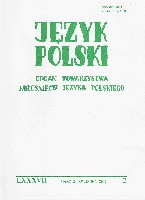Językowy obraz chłopa (rolnika, włościanina) w tekstach publicystycznych końca XVIII w.
The Linguistic Image of the Peasant in Journalistic Texts at the End of the 18th Century
Author(s): Józef JaworskiSubject(s): Language and Literature Studies
Published by: Towarzystwo Miłośników Języka Polskiego
Keywords: Linguistic image of world; peasant in Polish language; stereotypes; prototypes
Summary/Abstract: This article, referring to some elements of cognitive linguistics, is an attempt to provide a reconstruction of the stereotyped image of the peasant recorded in journalistic texts at the end of the 18th century. The constituents which make up the stereotype of the peasant are categorized into definite types of configurations of aspects (facets) such as social, moral, existential and physical. In the interpretation of different notions, the concept of the linguistic image of the world is applied. It is pointed out that the notion of the peasant present in the studied texts has profuse connotations. As found in the research, among the peasant’s characteristics, there is an overall predominance of positive traits like diligence, perseverance, patriotism, decisiveness, determination and valour in military actions; the negative traits relating to vices like drunkenness and conservatism. These traits, highlighted in particular configurations, constitute a relatively complete conceptual model (gestalt) of the peasant – considered here in the perspective of the journalistic texts from the end of the 18th century. In the formation of the image of the peasant in the source texts, diverse linguistic devices, mainly lexical and phraseological ones, are employed.
Journal: Język Polski
- Issue Year: 2007
- Issue No: 1
- Page Range: 55-65
- Page Count: 11
- Language: Polish

